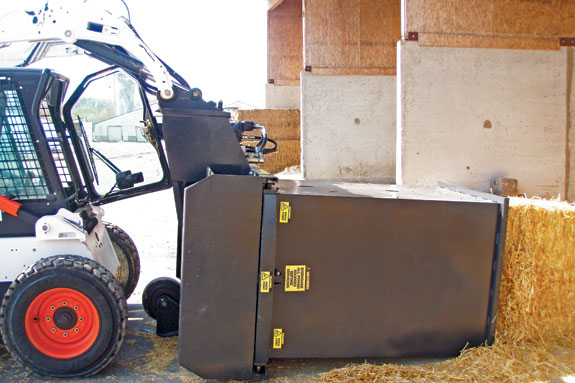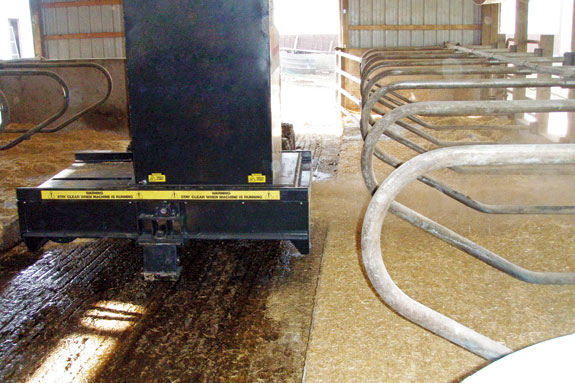This article was #5 in PDmag's Top 5 most-well read New Technology articles in 2010. Summary: This new bale chopper mounts right onto a skid loader for a one-step method to bedding with straw. The idea came to Roy Marschall, owner of Skid-Chopper, LLC, and his son-in-law, Harlan Poppler, who runs a dairy farm in the Twin Cities, Minnesota, area. The square drum attachment allows the operator to drive into the bale. Once lifted, hydraulic power moves the drum back while gravity pulls the bale over three rows of rotating three-sided blades to chop the straw. The speed of the drum can be altered to change the length of the cut. Two fans are used to blow the straw from the chopper directly into a freestall, bedded pack or collection pile. Fan speed can also be adjusted to control the distance the chopped straw travels. “It can blow up to 30 feet if you want it to,” Marschall says. Because this article was so popular, we asked Marschall some follow-up questions:
Q: What type of interest have you received? Can you quantify it in anyway?
MARSCHALL : I get calls every day and have a few demos lined up.
Q: Have you made any modifications to the original product?
MARSCHALL : We made a lot of adjustments in developing the product. Since the article appeared we shortened up the quick catch so the attachment sits closer to the skid loader. We also put two wheels in front instead of just one to help steady the unit.
Q: Are you working on any additional features, enhancements or new options?
MARSCHALL : Not at this time.
Q: Have any of your customers found a use or benefit you hadn’t thought of?
MARSCHALL : Not that I have heard of.
Q: Were there any hurdles that needed to be overcome?
MARSCHALL : We finished the patent process.
Q: What is the No. 1 reason customers cite for buying this product?
MARSCHALL : Convenience – because they can get into a lot of places. It also chops the straw instead of just shredding it. PD
PLUS , check out Progressive Dairyman 's Top 25 most well-read articles .
ARTICLE

It scoops. It chops. It blows. This new bale chopper mounts right onto a skid loader for a one-step method to bedding with straw.
The idea came to Roy Marschall, owner of Skid-Chopper, LLC, and his son-in-law, Harlan Poppler, who runs a dairy farm in the Twin Cities, Minnesota, area. They had been using sawdust to bed freestalls, but it was becoming hard to find and the prices were increasing with demand. With some help from friends at a fabrication shop, the two built a first-of-its-kind solution.
The square drum attachment allows the operator to drive into the bale. Once lifted, hydraulic power moves the drum back while gravity pulls the bale over three rows of rotating three-sided blades to chop the straw. The speed of the drum can be altered to change the length of the cut.
Two fans are used to blow the straw from the chopper directly into a freestall, bedded pack or collection pile. Fan speed can also be adjusted to control the distance the chopped straw travels.
“It can blow up to 30 feet if you want it to,” Marschall says.
With the chopper, Marschall and Poppler say they can utilize the wheat straw they already had and realize a cost savings of $700 to $800 per month over purchasing sawdust. Plus, they save time while bedding because the chopper can pick up the bale, chop the straw and dispense it all in one.
“We use it every day to bed all of our freestalls,” he says, noting one bale will bed all 147 freestalls in their dairy barn.

Midwest dairyman Arlen Bode also decided to switch to straw bedding after watching sawdust accumulate in his lagoon for 15 years. He heard about the new attachment and decided to try it on his 300-stall dairy in Gibbon, Minnesota.
“It’s a lot cheaper than sawdust,” he claims, figuring the machine will only take about a year to pay for itself.
He also feeds a little chopped straw in his dry cow ration and runs that through the chopper too. It was something he hadn’t planned on doing, but finds it to be working well.
Bode did say it is more time- consuming to bed stalls now than with his old method, but that’s because he prefers to chop the straw rather short (1.5 to 2 inches) so it breaks down better in the manure storage system. It takes two 3x3x8 bales of straw per barn to get the level of bedding he desires.
“It’s really important to have good straw – nice, clean straw without rocks,” he adds. At first, Bode used his own straw, but the last couple of months he’s hit some wet and hard bales that are hard on the chopper, so he had to purchase some cleaner, drier bales. However, it’s still cheaper than the $1,400 per load he was paying for sawdust, he says.
Bode was the first customer of this new machine and as Marschall learned more about its capabilities, he’d come to Bode’s farm to make modifications.
One modification Bode made was to purchase a bigger skid loader to better accommodate the power needed by the chopper.
Marschall says the chopper attachment is universal and will fit most modern skid loaders manufactured today.
The first chopper was built to handle 3x3x8-foot bales. Since then, he’s received calls about 4x3x8 bales and has built a second model that’s a little wider and heavier than the first.
Marschall also offers an attachment a hose for the chopper to blow straw into tighter areas like calf domes.
PHOTOS
TOP RIGHT: The drum of this new implement rotates down, allowing the operator to drive into the bale to load it.
TOP LEFT: With an adjustable fan speed, this equipment’s inventor claims its blower can throw straw up to 30 feet.
Photos courtesy of Skid-Chopper LLC.
The chopper costs $25,500 for the 3x3 size and $27,500 for the 3x4 size. It is not available at dealerships yet, but can be purchased by contacting Marschall through www.skidchopper.com or calling (952) 292-4091. PD
The following checklist can be used to determine if this new technology might be a fit for your operation.
Questions:
1. Do you need an easier way to chop straw on your farm?
2. Are you interested in converting to straw bedding?
3. Is your manure storage filling up with sand or sawdust?
4. Is straw an available bedding source in your area?
5. Do you feed straw in one or more of your rations?
6. Do you own a skid loader?
If you answered yes to four or more of these questions, this technology may be one for you to consider.

-
Karen Lee
- Midwest Editor
- Email Karen Lee






